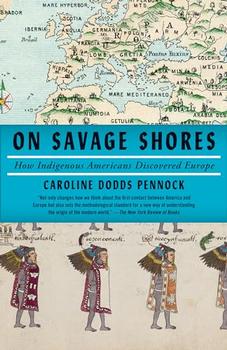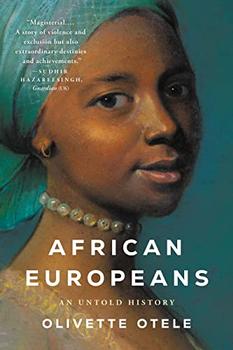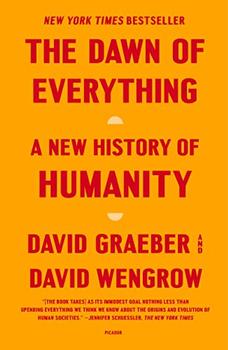Summary | Excerpt | Reviews | Beyond the book | Read-Alikes | Genres & Themes | Author Bio

How Indigenous Americans Discovered Europe
by Caroline Dodds PennockIn popular accounts of Christopher Columbus sailing across the ocean blue and "discovering" America in 1492, history appears to flow in one direction, from the "Old World" to the "New." But there were two acts of "discovery," so what was the experience like for Indigenous Americans?
On Savage Shores attempts to correct this oversight as historian and leading Aztec authority Caroline Dodds Pennock highlights stories of the Indigenous exploration of Europe and the complicated, often painful, relationships forged over centuries through enslavement, intermarriage, diplomacy and trade. Calling her work "a project of recovery," Pennock claims that academic historians ("with our supposedly esoteric interests") rarely discuss Indigenous Americans' experiences in Europe and that they are usually viewed as "oddities…spectacular curiosities, avatars of the riches and mysteries of far-off subjected lands." But they were anything but: They were diplomats, translators, nobles, servants, entertainers and vassals of European kings and queens. With each encounter in the "Old World," their contributions were "woven into the foundations of the world we live in today."
That being said, in the first encounters between the two populations, Native people were objectified and used by Europeans for their own gain. Columbus "seized and forcibly transported" anywhere from 3,000 to 6,000 Caribbean men, women and children to Europe in the late 15th century, most of whom were destined for work in domestic service or as translators. Pennock notes that the sources revealing this information are silent on the viewpoints of these people. It is a frustrating aspect of the book that turns up again and again, despite her best efforts to center Indigenous perspectives in the portrait she frames. The sources are like a "jigsaw," she writes: a piece here, a piece there…but no overarching Indigenous archive to describe the whole experience. As she explains, "We find ourselves trying to infer their attitudes from actions, piecing together their stories from the fragments of personal history which lie in the cracks" present in the more documented history of European interests and interactions with Indigenous peoples.
Pennock champions the historical presence and dignity of Native people in their encounters with Europe and its inhabitants. Even the book's title is a clever inversion of centuries of historical bias. The "savage shore" she writes about is Europe, as experienced by various Indigenous travelers. This upends and reframes popular conceptions of the word "savage" and who or what the appellation is often applied to. For example, in 1584, two Algonquian-speaking Native men, Mateo and Wanchese, traveled to London (willingly or coerced is not known) where the "looming islands of brick and stone were an alien world." Pennock says that Indigenous people were frequently "struck by the noise, dirt and poverty" of London, and perplexed by the "savage" extremes of wealth and poverty (an insight as relevant today as ever).
Along with the travels of Indigenous people, Pennock also exhaustively details the "stuff of life" that traveled from the Americas back to Europe, influencing its culture and pastimes. "Native people were the source of most of the 'novelties' that appeared in Europe during the sixteenth century," the most popular of which were tobacco and cacao, but which also included important food crops like maize, potatoes and tomatoes (see Beyond the Book). Indigenous people were part of the "tenuous commercial networks" that crept across the globe, Pennock claims, and their agency to conduct trade and commerce reveals their "enterprising and determined involvement in these fields."
One of the weaknesses of the book, although it seems to a certain extent unavoidable, is the absence of extant Indigenous primary sources. While a plethora of sources attest to historical European attitudes toward Indigenous groups, the view going the other way is harder to find in the record. Pennock admits "it is a serious problem for a scholar writing about Indigenous travelers," and she encourages readers and historians to attempt to overcome this weakness so that posterity "can recognize the importance of Indigenous peoples in European and global history." The relative lack of first-person Indigenous accounts in the book — both current and historical — is a limitation that results in a narrative frequently peppered with the author's own questions about what Native travelers might have seen, felt or thought about their interactions. The reader is invited to wonder, to imagine, but not necessarily to know what the experience of Indigenous people at this time was truly like.
Pennock does assert that the story of Indigenous travelers is an ongoing one. There are thousands of Native remains buried in cemeteries across Europe, "traces of [their] presence erased, but not forgotten." Indigenous peoples across the world want them back, "calling ever more loudly for the repatriation of their ancestors, thousands of whose remains are cataloged and hoarded in museums and private collections." Indigenous material objects hold sacred meaning and Pennock shares several examples of contemporary Native communities' efforts to retrieve that which belongs to them. She cites the words of Leila K. Blackbird, a historian of Apache and Cherokee descent, who wrote that "for many, if not all, Indigenous peoples, there is no separation between the past and present." And so the journey goes on.
Overall, On Savage Shores is an empathetic and essential contribution to Indigenous studies, richly detailed and passionately argued in its quest to elevate Native people's experience of discovery.
![]() This review
first ran in the March 1, 2023
issue of BookBrowse Recommends.
This review
first ran in the March 1, 2023
issue of BookBrowse Recommends.

If you liked On Savage Shores, try these:

by Olivette Otele
Published 2023
A dazzling history of Africans in Europe, revealing their unacknowledged role in shaping the continent.

by David Graeber, David Wengrow
Published 2023
A dramatically new understanding of human history, challenging our most fundamental assumptions about social evolution―from the development of agriculture and cities to the origins of the state, democracy, and inequality―and revealing new possibilities for human emancipation.
Your guide toexceptional books
BookBrowse seeks out and recommends the best in contemporary fiction and nonfiction—books that not only engage and entertain but also deepen our understanding of ourselves and the world around us.